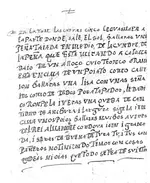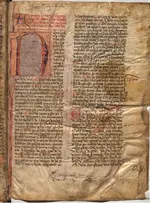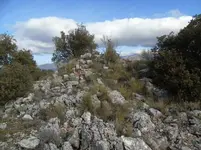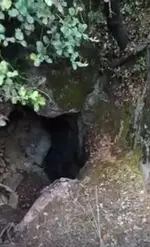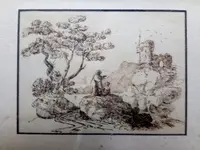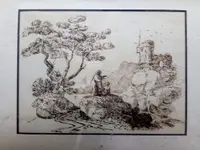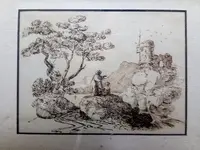Almanzor
Greenie
- Joined
- Jun 1, 2021
- Messages
- 12
- Reaction score
- 15
- Golden Thread
- 0
- Location
- Gallarin Tower
- Detector(s) used
- Nokta Makro Simplex Plus
- Primary Interest:
- Relic Hunting
- #1
Thread Owner
Since I was a child, my grandmother has told me the story of a great-great-grandfather who lived the great adventure (and hardships) of searching for treasure. That was not a minor or fleeting thing, he spent years trying to find it. He spent weeks in the mountains until his supplies ran out, he returned to the village for more and back to the mine. He got so deep that he opened several galleries with pick and shovel. Almost always alone, sometimes accompanied by my great-grandfather or a family member who would lend himself. Imagining what must have happened in that place in those times is what has led me to try to clarify the matter.
Apparently it all started because he dreamed of a mountain that he had never seen in which a great treasure was hidden. Months later, when he was riding his horse through the mountains, he saw that same mountain before his eyes. As if that were not enough, a great snowfall had fallen that covered the entire ground, except for the part of the mountain where he had dreamed that the treasure was located. My great-great-grandfather interpreted that as a sign, a turning point in his life, and since then, while the forces accompanied him, he continued digging.
Looking for information on this I came to a 1985 article downloaded in PDF on a mobile 30 years after its publication. When I read the legend of the Almanzor treasure, I began to connect the dots: My hypothesis is that my great-grandfather could have heard the story in the cortijo de la Torre (where he worked since he was a child), that it would have haunted him for years and that it no snow in the area of the mountain with which he had dreamed do the rest. Due to the dates I think it might even have coincided with the old man from Noalejo who told the story. But so that you can understand me, first I think you should read the article:
GALLARIN AND THE TREASURE OF KING ALMANZOR
Within the municipality of Noalejo, but very close to Arbuniel, is the Cortijo de la Torre, at the foot of the Atalaya hill, named for the small Arab construction that once stood on its top and from which today they are barely distinguished the ruined walls of its foundations. Not long ago, an old man from Noalejo told me the story of a certain Moorish king who inhabited these places and of a great treasure that this land keeps in his bowels.
At the time of the greatest Muslim splendor, this farmhouse was in the power of a Moor named Gallarin, who had appropriated an extensive territory throughout the region at the expense of the Conquest. Next to his place of residence and on top of a hill he had ordered the construction of a tower from where he could see a wide territory strewn with fortresses and watchtowers whose smoke warned him of the dangers of enemy incursions.
This Moorish gyrfalcon had the friendship and trust of a very important character, King Almanzor, that leader who had won more than eighty battles, and he frequently received visits from him in his hidden corner of Sierra M?gica. In one of them, Almanzor, as a premonitory gesture of the tragic end of him in Calata?azor, proposed to hide in some secret place of his property all the treasures that he had accumulated throughout his forays through the peninsular soil.
Thus it was that with the assistance of the closest subjects of Gallar?n they excavated a deep underground with suitable chambers where Almanzor was placing all his wealth. Among them stood out the nine horses loaded with gold and the famous necklace of the Queen of Naples, it also introduced abundant weapons, swords, mounts, etc., as if to provide a great army and, in addition, a portrait of all the Moors who during centuries they had crossed the strait to step on Spanish land (15). But once the work was finished and after the entrance to the cave was completely camouflaged, Almanzor rejected his friend and engineered a betrayal that ended with the death of Gallar?n and all his collaborators. He demolished his palace and the watchtower that he had built on the mountain, to such an extent that there was no trace that the land had been populated at any time.
It was not long when the Arab minister had to leave Segovian lands defeated and persecuted until he met death at the gates of Medinaceli, leaving his treasure anonymous forever.
According to my septuagenarian informant, that when he was young he had worked a lot in this farmhouse, a very wealthy woman lived near Cambil who was very friendly with the bishop of Ja?n. She often visited the prelate and brought him good gifts. On one occasion, the bishop, in return for her friendship, gave him a copy of the will of King Almanzor, which was in the Archives of the Jaen cathedral. The curious thing about this document was the precise description it gave of a very specific place located some thirty kilometers from the capital, and which according to a unanimous opinion could very well be a treasure.
This woman kept the document in her farmhouse with the idea of one day paying a little attention to it, something that never happened, because soon after a serious illness ended her life. The farmhouse then passed into the hands of the patrons of my interlocutor and guide in this story, being present when the new owners discovered the document. They read it aloud, not at first understanding its meaning, and when they suspected what it might be they jealously guarded the paper where no one could find it. But they did not have the alert memory of her girl, that she learned the text in a row and that it would be as follows:
Five leagues from Ja?n, site of the Tower, the most important landmarks: the hill of the Cabras and the castle demolished in the watchtower that can see seven towers. The land that exists there has fingers and tips and stripes on the stones. A black tree with a very thick trunk and some sloes. Three stone mogotes made by human hands, one in front of Coloma and the others next to it. From one of them a stone track descends, when it ends, three meters in the direction of the rising sun, a stone as wide as it is long covers a hole and then a wide and long corridor, do not pay attention to what you see or hear Keep going until you see, at the end, two large poyos.
At first the investigations were directed to the castle of Arenas, in the term of Campillo de Arenas, where, according to what they say, more than a fortune has been wasted digging tunnels in the surroundings, and even the life of some unfortunate who risked it by going up its dangerous walls.
As nothing was found, the surveys changed scenery, taking place more recently in the Cortijo de la Torre, without us knowing of any important discovery to date.
The funny thing is that until relatively recently it was thought that Gallarin and his Tower were a Legend, but recently archaeologists in the area have discovered his Tower in a place that on ancient maps is known as the Gallarin Gorge. Other relevant details are that this tower is right on a mountain called Alta Coloma, as in the legend and that at about 90 degrees to the right there is a castle demolished on a Watchtower that is more than 1200 years old.
I have moved to live in this area and I have been investigating the place for a year. The area is full of signs such as ceramic remains from that time. There is also documentation on findings of coins and cemeteries carved in stone.
I have more information and even the translation of the document that was in the cathedral of Jaen, but I will reserve that for future publications if I see that the subject raises interest.
I am Spanish, sorry for my English.
Greetings from the land of Gallarin.
Apparently it all started because he dreamed of a mountain that he had never seen in which a great treasure was hidden. Months later, when he was riding his horse through the mountains, he saw that same mountain before his eyes. As if that were not enough, a great snowfall had fallen that covered the entire ground, except for the part of the mountain where he had dreamed that the treasure was located. My great-great-grandfather interpreted that as a sign, a turning point in his life, and since then, while the forces accompanied him, he continued digging.
Looking for information on this I came to a 1985 article downloaded in PDF on a mobile 30 years after its publication. When I read the legend of the Almanzor treasure, I began to connect the dots: My hypothesis is that my great-grandfather could have heard the story in the cortijo de la Torre (where he worked since he was a child), that it would have haunted him for years and that it no snow in the area of the mountain with which he had dreamed do the rest. Due to the dates I think it might even have coincided with the old man from Noalejo who told the story. But so that you can understand me, first I think you should read the article:
GALLARIN AND THE TREASURE OF KING ALMANZOR
Within the municipality of Noalejo, but very close to Arbuniel, is the Cortijo de la Torre, at the foot of the Atalaya hill, named for the small Arab construction that once stood on its top and from which today they are barely distinguished the ruined walls of its foundations. Not long ago, an old man from Noalejo told me the story of a certain Moorish king who inhabited these places and of a great treasure that this land keeps in his bowels.
At the time of the greatest Muslim splendor, this farmhouse was in the power of a Moor named Gallarin, who had appropriated an extensive territory throughout the region at the expense of the Conquest. Next to his place of residence and on top of a hill he had ordered the construction of a tower from where he could see a wide territory strewn with fortresses and watchtowers whose smoke warned him of the dangers of enemy incursions.
This Moorish gyrfalcon had the friendship and trust of a very important character, King Almanzor, that leader who had won more than eighty battles, and he frequently received visits from him in his hidden corner of Sierra M?gica. In one of them, Almanzor, as a premonitory gesture of the tragic end of him in Calata?azor, proposed to hide in some secret place of his property all the treasures that he had accumulated throughout his forays through the peninsular soil.
Thus it was that with the assistance of the closest subjects of Gallar?n they excavated a deep underground with suitable chambers where Almanzor was placing all his wealth. Among them stood out the nine horses loaded with gold and the famous necklace of the Queen of Naples, it also introduced abundant weapons, swords, mounts, etc., as if to provide a great army and, in addition, a portrait of all the Moors who during centuries they had crossed the strait to step on Spanish land (15). But once the work was finished and after the entrance to the cave was completely camouflaged, Almanzor rejected his friend and engineered a betrayal that ended with the death of Gallar?n and all his collaborators. He demolished his palace and the watchtower that he had built on the mountain, to such an extent that there was no trace that the land had been populated at any time.
It was not long when the Arab minister had to leave Segovian lands defeated and persecuted until he met death at the gates of Medinaceli, leaving his treasure anonymous forever.
According to my septuagenarian informant, that when he was young he had worked a lot in this farmhouse, a very wealthy woman lived near Cambil who was very friendly with the bishop of Ja?n. She often visited the prelate and brought him good gifts. On one occasion, the bishop, in return for her friendship, gave him a copy of the will of King Almanzor, which was in the Archives of the Jaen cathedral. The curious thing about this document was the precise description it gave of a very specific place located some thirty kilometers from the capital, and which according to a unanimous opinion could very well be a treasure.
This woman kept the document in her farmhouse with the idea of one day paying a little attention to it, something that never happened, because soon after a serious illness ended her life. The farmhouse then passed into the hands of the patrons of my interlocutor and guide in this story, being present when the new owners discovered the document. They read it aloud, not at first understanding its meaning, and when they suspected what it might be they jealously guarded the paper where no one could find it. But they did not have the alert memory of her girl, that she learned the text in a row and that it would be as follows:
Five leagues from Ja?n, site of the Tower, the most important landmarks: the hill of the Cabras and the castle demolished in the watchtower that can see seven towers. The land that exists there has fingers and tips and stripes on the stones. A black tree with a very thick trunk and some sloes. Three stone mogotes made by human hands, one in front of Coloma and the others next to it. From one of them a stone track descends, when it ends, three meters in the direction of the rising sun, a stone as wide as it is long covers a hole and then a wide and long corridor, do not pay attention to what you see or hear Keep going until you see, at the end, two large poyos.
At first the investigations were directed to the castle of Arenas, in the term of Campillo de Arenas, where, according to what they say, more than a fortune has been wasted digging tunnels in the surroundings, and even the life of some unfortunate who risked it by going up its dangerous walls.
As nothing was found, the surveys changed scenery, taking place more recently in the Cortijo de la Torre, without us knowing of any important discovery to date.
The funny thing is that until relatively recently it was thought that Gallarin and his Tower were a Legend, but recently archaeologists in the area have discovered his Tower in a place that on ancient maps is known as the Gallarin Gorge. Other relevant details are that this tower is right on a mountain called Alta Coloma, as in the legend and that at about 90 degrees to the right there is a castle demolished on a Watchtower that is more than 1200 years old.
I have moved to live in this area and I have been investigating the place for a year. The area is full of signs such as ceramic remains from that time. There is also documentation on findings of coins and cemeteries carved in stone.
I have more information and even the translation of the document that was in the cathedral of Jaen, but I will reserve that for future publications if I see that the subject raises interest.
I am Spanish, sorry for my English.
Greetings from the land of Gallarin.



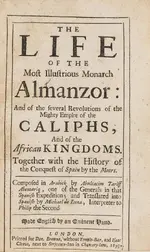

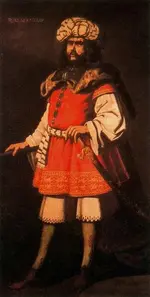
 I did not know that particular book and I am trying to get a translation in Spanish. Although this treasure story does not seem to have attracted much attention, perhaps because Almanzor is not known on the other side of the ocean, I am going to put a little more meat on the grill.
I did not know that particular book and I am trying to get a translation in Spanish. Although this treasure story does not seem to have attracted much attention, perhaps because Almanzor is not known on the other side of the ocean, I am going to put a little more meat on the grill.